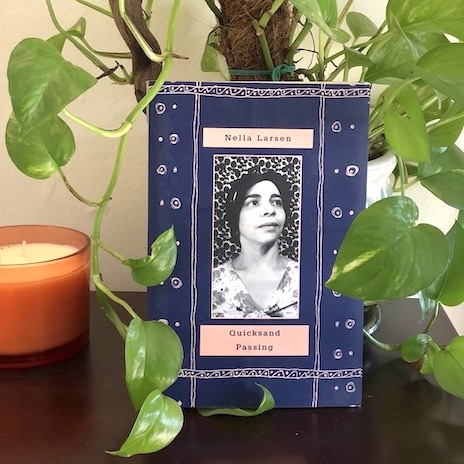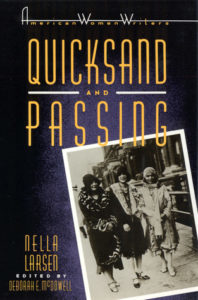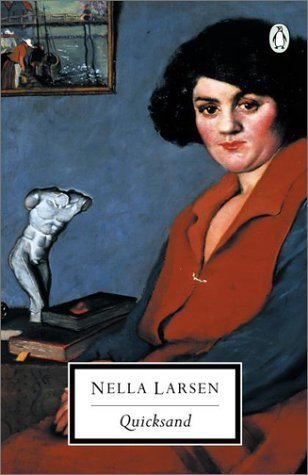Passing by Nella Larsen (1929)
Passing by Nella Larsen (1929) is one of the most iconic novels of the Harlem Renaissance era of the 1920s, the New York City-centered movement that celebrated the ascendence of black writers, artists, and performers.
Nella Larsen was the first African-American woman to graduate from library school and to receive the Guggenheim Fellowship for creative writing. As the daughter of a white Danish immigrant mother and a mixed-race father from the Danish West Indies, the theme of her life, and in effect, her work, was a sense of never belonging — not to any community, nor even to an immediate family.
Though her first novel, Quicksand (1928), contained more obviously autobiographical elements, Passing also reflected the author’s lifelong sense of alienation and search for identity.
In length, Passing might be considered a novella, yet within its spare prose lies deep ideas and much to ponder. The 2001 Griot Edition describes it succinctly:
“In Passing, Clare Kendry, a poor, fair-skinned woman, passes for white and marries a wealthy white man. Seeking to fulfill a need for the company of black folks, she renews a friendship with Irene Redfield, who has married a physician and becomes a member of Harlem’s black elite.
As Clare spends more time in Harlem, her search for community becomes dangerous in the face of her blatantly racist husband who believes he has never even met a black person. Clare yearns for a closeness with Irene that she cannot name but which reads as incredibly homoerotic.
‘Passing’ is not only a direct reference to Clare’s decision to live as a white woman but also her suppression of her sexuality. It also calls attention to the other kinds of ‘passing’ women do in relationships romantic and otherwise, and the adoption by the black middle class of the actions and values of the dominant culture.”
Highly recommended is a critical essay by Claudia Tate titled “Nella Larsen’s Passing: A Problem of Interpretation.” It begins:
“Nella Larsen’s Passing (1929) has been frequently described as a novel depicting the tragic plight of the mulatto. In fact, the passage on the cover of the 1971 Collier edition refers to the work as ‘the tragic story of a beautiful light-skinned mulatto passing for white in high society.’
It further states that Passing is a “searing novel of racial conflict …” Though Passing does indeed relate the tragic fate of a [mixed-race] woman who passes for white, it also centers on jealousy, psychological ambiguity, and intrigue.
By focusing on the latter elements, Passing is transformed from an anachronistic, melodramatic novel into a skillfully executed and enduring work of art.”
. . . . . . . . . .

Learn more about Nella Larsen
. . . . . . . . . .
Passing as an exploration of cultural identity
The following insights are excerpted from the Introduction by Thadious M. Davis to the 1992 Penguin Books edition of Passing:
“In Passing (1929), Nella Larsen explores the cultural identity and psychological positioning of modern black individuals unmarked by difference from whites.
Locating her narrative within the liberating 1920s, the golden days of black cultural consciousness, she critiques a societal insistence on race as essential and fixed by representing racial fluidity inherent in Clare Kendry Bellew and Irene Westover Redfield, women who choose their racial identities.
In portraying Clare, who becomes white, and Irene, who passes occasionally, Larsen represents passing as a practical, emancipatory option, a means by which people of African descent could permeate what W.E.B. Du Bois themed ‘the veil of color caste.’
Larsen defines passing in a meeting between Clare and Irene as a simple but ‘hazardous business,’ requiring ‘breaking away from all that was familiar and friendly to take one’s chance in another environment, not entirely strange, perhaps, but certainly not entirely friendly.’
Basing her definition on readable social texts, she concludes that by changing their environment or social structures, passers disrupt social meanings and avail themselves of both basic human and fundamental constitutional rights enjoyed by the white majority.
With such certain rewards for so easy a move, Clare ‘wondered why more coloured girls … never ‘passed’ over. It’s such a frightfully easy thing to do. If one’s the type, all that’s needed is a little nerve.’
Passing, according to Clare, is a movement in gesture as well as in space: a psychological, social, cultural movement signaling both a reconfiguration of the self and consolidation of one’s cultural identity, but not a valuation of one’s physical body.
… In creating characters like Irene, her physician husband, and their designer-dressed, college-educated friends, Larsen reduced the material difference in lifestyle between blacks and whites of the middle class and freed her narrative of the more obvious markers of racial identity.”
. . . . . . . . .
Quicksand & Passing by Nella Larsen on Amazon*
. . . . . . . . .
Marriage in Harlem: A 1929 Review of Passing
From the original review of Passing in the Baltimore Evening Sun, June 15, 1929: Just as in the author’s first novel, Quicksand, you are made vividly aware of the intellectual Negro temperament, of the barriers existing between blacks and whites and of the utter inability of either side to remove them.
Harlem has its Negro city with walls as definite as the walls of Troy. Although they allow whites to bring in an occasional friendly wooden horse, to listen to their songs or discuss art with their intelligentsia, they nonetheless have rationalized for themselves an impenetrable defense against hostile attitudes. All of this is forcibly brought out in Miss Larsen’s novel.
The plot deals with the reactions of Clare Kendry, a veritable Helen, who has been “passing” for white since childhood. She is the wife of a rich New Yorker who loudly hates Negroes. It tells of Irene, who also could have passed, but married her dark Dr. Bryan, a profound intellectual, instead. She lives in Harlem, is loyal to her race, and is president of the Negro Welfare League.
Unable to endure the mental solitude which must be a part of every instance of “passing,” and the bantering remarks of her husband about “her own people,” Clare looks up her childhood Harlem friends. She is obsessed with a passion for sympathy and understanding.
She takes it from Irene, Dr. Bryan, and others against their will by means of her vivid, electric personality. In fact, she instills into a peaceful segment of Harlem a neurasthenia which is only dispelled by her husband’s recognition of her identity and her own tragic end.
Passing will interest both the prejudiced and unprejudiced mind because of its straightforwardness, its bold dramatic strokes, and its sincere appeal for analysis from a writer who must herself have been through the conflicts of the characters she portrays.
. . . . . . . . . .
You might also like: Quicksand by Nella Larsen
. . . . . . . . .
*This is an Amazon Affiliate link. If the product is purchased by linking through, Literary Ladies Guide receives a modest commission, which helps maintain our site and helps it to continue growing!
The post Passing by Nella Larsen (1929) appeared first on Literary Ladies Guide.





